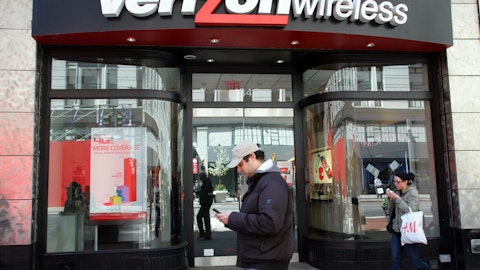3M Company (NYSE:MMM) Q4 2023 Earnings Call Transcript January 23, 2024
3M Company beats earnings expectations. Reported EPS is $2.42, expectations were $2.31. 3M Company isn’t one of the 30 most popular stocks among hedge funds at the end of the third quarter (see the details here).
Operator: Ladies and gentlemen, thank you for standing by. Welcome to the 3M Fourth Quarter Earnings Conference Call. [Operator Instructions] As a reminder, this conference is being recorded, Tuesday, January 23, 2023. I would now like to turn the call over to Bruce Jermeland, Senior Vice President of Investor Relations at 3M.
Bruce Jermeland: Thank you, and good morning, everyone and welcome to our fourth quarter earnings conference call. With me today are Mike Roman, 3M’s Chairman and Chief Executive Officer; and Monish Patolawala, our President and Chief Financial Officer. Mike and Monish will make some formal comments and then we will take your questions. Please note, that today’s earnings release and slide presentation accompanying this call are posted on the homepage of our Investor Relations website at 3m.com. Please turn to Slide 2. Please take a moment to read the forward-looking statement. During today’s conference call, we will be making certain predictive statements that reflect our current views about 3M’s future performance and financial results.
These statements are based on certain assumptions and expectations of future events that are subject to risks and uncertainties. Item 1A of our most recent Form 10-Q lists some of the most important risk factors that could cause actual results to differ from our predictions. Please note, throughout today’s presentation, we will be making references to certain non-GAAP financial measures. Reconciliations of the non-GAAP measures can be found in the attachments to today’s press release. Please turn to Slide 3. During today’s presentation, Mike and Monish will discuss our 2024 outlook. This outlook will be provided on the same adjusted basis used during 2023. In the coming months, there are significant milestones that the company expects to complete, including the spin-off the Health Care business and the finalization of the public water supplier and combat arms legal settlements.
The Health Care spend remains on-track for the first half of 2024, subject to customary closing conditions as detailed in our SEC filings. We continue to expect the business to be spun-off with an estimated net leverage of 3x to 3.5x EBITDA, and with the proceeds to be distributed to 3M prior to the completion of the spin. We are working through the processes, with all parties and the courts in both the public water supplier and Combat Arms Earplugs legal settlements. Our goal is our finalization and ultimate implementation. Absent the proceeds from the intended spin-off of the Health Care business, the company has not concluded, how it would fund amounts due under the public water supplier and Combat Arms Earplugs legal settlements. Therefore, we have not included the potential impacts of changes in net debt that may be needed to fund amounts under these agreements.
For illustrative purposes only, in the absence of the proceeds from the spin, the adjusted earnings per share impact from financing legal settlements could be up to approximately a $0.20 per share headwind based on current market conditions. Also, please note that we will be treating the dilutive earnings impact of 3M’s option to satisfy the $1 billion in payments related to the Combat Arms Earplug settlement with 3M’s shares as an adjustment in arriving at results adjusted for special items. Finally, it is important to note that when considering 3M’s financials post spin, it is not appropriate to simply remove the Health Care business financial results. There are other factors such as transition services agreements, stranded cost and below the line items that need to be taken into account.
We are planning on holding an investor meeting later this year, following the spin of Health Care where we will provide an update to our full year 2024 guidance along with our medium-term financial framework. With that, please turn to Slide 4. And I’ll now hand the call off to Mike. Mike?
Mike Roman : Thank you, Bruce. Good morning, everyone, and thank you for joining us. 3M delivered a strong fourth quarter as we continued to improve our operational performance, with adjusted EPS growth of 11%, operating margin expansion of 180 basis points and robust cash flow. Monish will cover more details of the quarter, but first, I would like to comment on our full year performance. Throughout 2023, we delivered on our commitments with results that exceeded our original earnings and cash flow guidance. While organic sales declined 3%, reflecting softness in certain end markets, including consumer retail and electronics, our disciplined execution supported year-over-year adjusted margin expansion. Excluding restructuring, we delivered increased margins of 60 basis points, helping drive earnings of $9.24 per share, along with a 30% increase in free cash flow and a conversion rate of 123%.
Our strong cash flow enabled us to continue investing in the business, while reducing net debt by $2 billion or 17%, and returning $3.3 billion to shareholders through our dividend. Please turn to Slide 5. As you recall, in January of last year, we committed to take a deeper look at everything we do. Our success in 2023 reflects that commitment along with our execution of three strategic priorities, which are unlocking value for customers and shareholders, both today and into the future. Let me highlight key achievements in these areas, including how we will build on our progress in 2024. Starting with driving performance through the 3M model. In 2023, we implemented the most significant restructuring in 3M’s history to streamline the organization, reduce costs at the center, and get us closer to our customers, which generated more than $400 million in savings during the year.
These efforts included aggressively cutting management layers, reducing corporate shared services and modernizing our technology by removing hundreds of legacy systems. We reduced rooftops worldwide and took actions to help us address stranded costs, as we progress the Health Care spend. We simplified our supply chains and are doing more to leverage data and data analytics to visualize the flow of goods, so we can serve customers more efficiently. We optimized our global go-to-market models for each of our business groups. And consumer for example, we simplified our division structure with each of our global area teams now better aligned around their prioritized product portfolios and brands. At the same time, we have transitioned to an export-led model in approximately 30 smaller countries around the world, allowing us to reduce costs and complexity while still bringing 3M innovation to local customers.
The simplification of our organization also frees up resources to prioritize exciting growth opportunities for 3M, such as automotive electrification, climate technology and industrial automation. While we have more work to do in 2024, our actions are helping us to improve our operational performance and create a more competitive 3M. Our next priority is the spin-off of Solventum, our Health Care business. Last year, we appointed experienced Health Care leaders to Solventum, including Bryan Hanson as CEO, Carrie Cox as Board Chair, and Wayde McMillan as CFO. The spin is on track to be completed in the first half of this year, and we are confident in the value it will create for customers, care providers, patients and shareholders. As we look to 2024, we will continue to optimize our portfolio as we prioritize geographies, markets and products, where we see the greatest opportunity.
Finally, we are focused on addressing risk and uncertainty. The Combat Arms settlement we announced last August has received strong support from both claimants and the broader military community. We completed the first three milestones of the settlement as planned, including earlier this month, when we reached agreement with all plaintiffs, who were being prepared for trial. We will continue to work with all parties in the courts to fully implement the settlement. With respect to PFAS, our settlement with public water suppliers is on track for the final approval hearing scheduled for February 2nd. We will continue to address other PFAS litigation by defending ourselves in court or through negotiated resolutions as appropriate. We also remain on schedule to exit all PFAS manufacturing by the end of 2025, with production volumes down 20%.
Looking back, in a year full of change, I am pleased how 3Mers around the world stepped-up to lead. Importantly, we stayed relentlessly focused on doing what 3M does best, using material science to make a difference in the world. I see exciting examples of innovation across our company. Earlier this month, we unveiled the world’s first solar powered communications headset, building on our decades of leadership in both personal safety and sustainability. We are advancing more durable, energy efficient and connected vehicles with an array of solutions, including new thermal barrier materials that improve the range and safety of electric car batteries, just one element of our automotive electrification program, which grew 30% in 2023, on top of 30% growth in 2022.
Our Medical Solutions business, a world leader in advanced wound care, just announced a partnership with the U.S. Army, where we will collaborate with the military and leading universities to develop traumatic wound solutions. And in Consumer, last year, we launched more than a dozen new products, including new solutions for heavyweight hanging, part of our $0.5 billion Command franchise, which leverages our world-class adhesives technology. 3M’s innovation engine is strong. It will remain the heart of our business and our ability to deliver differentiated value for our customers. In summary, the 3M team delivered a successful 2023, and I am confident we will accelerate our progress in the coming year. I will come back to talk about our 2024 priorities and guidance after Monish takes you through the details of the fourth quarter.
Monish?
Monish Patolawala: Thank you, Mike, and I wish you all a very good morning. Please turn to Slide 6. The fourth quarter culminated a year where we took significant steps to improve our operational execution, resulting in better financial performance. We aggressively controlled spending and initiated restructuring actions to simplify our supply chains, reduce structure and streamline our go-to-market models to better serve customers. At the same time, we continue preparing for the successful spin of our Health Care business and work to reduce risks and uncertainties related to legal matters. While there is more to do, our teams made tremendous progress in 2023 that we build upon in 2024 and beyond. Looking at fourth quarter performance, adjusted sales were $7.7 billion at the high-end of our guidance.
End markets continue to play out as anticipated. Notably, the auto OEM market remains strong in the fourth quarter and we saw signs of end market stabilization in consumer electronics. As expected, China and consumer retail end markets continue to be soft. Organic sales on an adjusted basis declined 1.4% versus last year. The expected decline in demand for disposable respirator negatively impacted organic growth by 60 basis points of $50 million. Excluding this impact, Q4 adjusted organic sales were down 80 basis points. Adjusted operating margins were 20.9%, up 180 basis points year-on-year or up 320 basis points excluding the impact of restructuring charges. Adjusted earnings were $2.42 up 11% year-on-year. Versus our guidance, fourth quarter earnings were benefited by $0.06 due to a lower-than-expected tax rate which was partially offset by the acceleration of restructuring actions which impacted earnings by approximately $0.03.
And finally, fourth quarter adjusted free cash flow was $2 billion up 18% year-on-year. For the full year, we delivered $6.3 billion in adjusted free cash flow versus an originally expected range of $4.2 billion to $5 billion at the start of the year. Please turn to Slide 7 for a recap of the components that drove our year-on-year operating margin and earnings performance. Benefits from manufacturing productivity, sourcing actions, restructuring, strong spending discipline and selling prices more than offset headwinds from lower sales volumes, investments in the business and last year’s disposable respirator sales comparison. This net benefit drove a year-on-year expansion in Q4 operating margins of 400 basis points and earnings per share of $0.43 per share.
Pre-tax restructuring and related charges in the quarter were $109 million, or a negative impact to margins of 140 basis points and $0.17 to earnings. Raw material, logistics and energy cost inflation was a slight year-on-year headwind of 10 basis points to operating margins or minus $0.01 to adjusted earnings per share. Foreign currency translation was a negative 70 basis points impact to adjusted operating margins are negative $0.07 per share. This result was primarily due to the net impact of hedging and the devaluation of the Argentinean peso. As previously mentioned, our adjusted tax rate was lower-than-expected coming in at 14.9%. This compared to 16.6% in last year’s fourth quarter, resulting in a $0.05 benefit to earnings. And finally, other financial items and shares outstanding netted to a positive $0.01 per share year-on-year impact.
Please turn to Slide 8. Fourth quarter adjusted free cash flow was $2 billion, up 18% year-on-year with conversion of 145%, up 800 basis points versus last year’s Q4. Our ongoing focus on working capital management, especially inventory, continues to yield results. Inventory was down $550 million year-on-year and is now at 14.8% of sales, a 90 basis points improvement year-on-year. I am pleased with the progress to-date and see significant opportunity to further improve performance in all aspects of working capital. Adjusted capital expenditures were $308 million, down 32% versus last year’s abnormally high fourth quarter. For the year, we invested over $1.4 billion versus an expected range of $1.3 billion to $1.5 billion. And finally, we returned $828 million to shareholders via dividends during the quarter.

Turning to the balance sheet. Net debt at the end of Q4, stood at $10 billion, a decline of $2 billion year-on-year or 17%. 3M continues to be a reliable and robust cash generator. In addition, the upcoming spin-off our Health Care business will further strengthen our balance sheet. As Bruce mentioned, we anticipate receiving a 1x dividend from Solventum at an initial leverage of 3x to 3.5x EBITDA. We will also retain a 19.9% equity stake, which will provide additional liquidity. This combined with our existing strong capital structure provides us with the ability to continue to invest in the business, return capital to shareholders and meet the cash flow needs related to ongoing legal matters. Now please turn to Slide 10 for a discussion on our business group performance.
Starting with our Safety and Industrial business, which posted sales of $2.7 billion, down 3.9% organically. The expected decline in demand for disposable respirators was a headwind of approximately $50 million negatively impacting segment organic growth by 160 basis points. Organic growth was led by a double-digit increase in roofing granules, while industrial adhesives and tapes was flat, while all other businesses declined. Geographically, core industrial markets in the United States were relatively strong, while China remained weak. Our businesses were impacted by reduction in channel inventory towards the end of the quarter, particularly in the Greater China and EMEA regions, as channel partners manage cash and are cautious as we enter 2024.
Adjusted operating income was $524 million, down 6% versus last year. Adjusted operating margins were 19.7%, down 70 basis points year-on-year. This decline was driven by lower sales volumes which was partially offset by benefits from restructuring, pricing and strong spending discipline. Moving to Transportation and Electronics, which posted sales of $1.8 billion or up 2.7% organically. Our auto OEM business continued to perform well and increased 13% versus a 9% increase in global car and light truck bills. The Electronics business was flat organically year-on-year as demand for consumer electronic devices began to stabilize, while semiconductor remains soft. We continue to closely monitor these trends and are well-positioned to grow with our customers in these large and important end markets.
Looking at the rest of Transportation and Electronics, Advanced Materials grew organically high single-digits, Commercial Solutions grew low-single-digits and Transportation Safety declined –single-digits. Transportation and Electronics delivered $370 million in adjusted operating income, up 28% year-on-year. Adjusted operating margins were 20.9%, up 380 basis points versus Q4 last year. The team achieved this result through restructuring actions, pricing and strong spending discipline. Turning to our Health Care business. Q4 sales were $2 billion or down 1% organically versus last year. Sales in our Medical Solutions business grew low-single-digits organically, while Separation and Purification and Oral Care were both down low-single-digits.
Health Information Systems organic sales decreased high-single-digits. Looking at the year, our businesses within Health Care continued to see lingering COVID related impacts. Full year organic growth in Health Care was approximately 1% with both Medical Solutions and Oral Care posting positive low-single-digit growth, while Health Information Systems and Separation and Purification were both down low-single-digits. Health Care’s fourth quarter operating income was $372 million down 10% year-on-year. Operating margins were 18.3% or down 1.9 percentage points with adjusted EBITDA margins of 26%. Year-on-year adjusted operating margins were impacted by lower sales volumes along with added costs associated with the pending spin. Lastly, the Consumer business posted fourth quarter sales of $1.2 billion.
Organic sales declined 2.2% year-on-year. Home improvement increased low-single-digits organically, while Home Health and Auto declined low-single-digits and Stationery and Office declined high-single-digits. Geographically, organic growth was down slightly in the U.S., while EMEA was down mid-single-digits and Asia Pacific declined low-double-digits. Consumer’s fourth quarter operating income was $221 million, up 4% compared to last year. With operating margins of 18%, up 100 basis points year-on-year. The improvement in operating margins was driven by benefits from restructuring actions, portfolio optimization, strong spending discipline and productivity actions. Before I turn it back to Mike for him to discuss outlook for 2024, I wanted to take a moment to reflect on our 2023 total company performance.
As the year progressed, we made strong improvements in adjusted operating margins. For reference, Slide 23 in the appendix provides our quarterly adjusted operating margin recon for the year. As you can see, we delivered significant improvement in performance, particularly when setting aside the impact from restructuring charges. Please turn to Slide 12, and I will now turn the call back over to Mike. Mike?
Mike Roman : Thank you, Monish. We are entering 2024 with strong momentum from our strategic priorities as we build on the actions taken in 2023. We will remain focused on improving operational performance as we progress our restructuring, while driving even greater supply chain productivity and inventory reductions. These represent significant opportunities to deliver sustainable margin and cash flow expansion in 2024. We will also further accelerate efforts to optimize our portfolio, which has been an ongoing strategy for 3M. In addition to finalizing the Health Care spin, we will continue implementing our geographic prioritization strategy. We will also step up our efforts to prioritize our product portfolios based on market potential, right to win, supply chain complexity, margins and returns.
For example, in our Consumer business, we have identified approximately 5% of the portfolio where we have limited market growth and a poor right to win. While exiting these portfolios will impact consumers’ growth rate in the near-term, these actions will better focus our efforts on products that best utilize 3M invention and ultimately drive improved growth and margins in the long-term. At the same time, 3M succeeds across market cycles because we remain close to customers and invest in innovation. We will continue to invest in R&D and capital expenditures, enabling us to win in our core and also in new attractive markets where 3M can make a difference. Finally, we will stay focused on reducing risk and uncertainty by proactively and effectively managing litigation, including finalizing legal settlements.
We will advance the ramp down of PFAS manufacturing while continuing to make progress on our sustainability goals. In 2024, for example, we expect to complete the investments in state-of-the-art water filtration technology across our chemical manufacturing sites. Please turn to Slide 13. Based on these focus areas, along with the macroeconomic outlook, we are laying out our guidance for 2024. We expect the execution of our priorities to support the strengthening of our competitive position, continued underlying margin improvement and strong cash flows as we aggressively manage working capital. As we start 2024, the macro environment remains muted, similar to what we saw in the fourth quarter. On an adjusted basis, we anticipate organic full year growth of flat to plus 2%.
Excluding the impact from geographic prioritization and portfolio actions, we expect organic growth of 1% to 3%. With respect to EPS, we anticipate earnings of $9.35 to $9.75 per share. We expect continued strong margin expansion, along with another year of strong cash flow with an adjusted conversion rate of 95% to 105%. As Bruce noted, following the completion of the Health Care spin, we will host an investor meeting and provide strategic updates along with updated guidance for 3M. As always, underpinning our success will be the strengths of 3M, our industry-leading material science, advanced manufacturing, global capabilities and iconic brands, along with some of the best and brightest people around the world. Before I turn it back to Monish, let me repeat a few important points.
As I look across 3M, a 2023 was a pivotal year for our enterprise. We executed our plans and delivered on our commitment to exit the year stronger, leaner and more focused. We improved our operational performance advance the spin-off of Solventum and address risk and uncertainty. I am proud of everything we accomplished in 2023, and equally excited about the year ahead. We are in excellent position to build on our progress, continue to improve our operational performance and deliver another successful year. I thank all 3Mers for their dedication and for everything they do for our company. I will now turn it over to Monish for more details on our guidance. Monish?
Monish Patolawala: Thanks, Mike. Please turn to Slide 14. As Mike highlighted, we expect another year of strong execution on our priorities, including strengthening our competitive position, continued margin improvement and robust cash flows as we aggressively manage working capital. Let’s now look at our 2024 expected performance for our business segments. Starting with Safety and Industrial, where we estimate organic sales growth to be flat to up low-single-digits. As we start the year, we continue to see demand in industrial end markets remaining mixed. Full year 2024, industrial production forecast is currently expected to be at approximately 2% worldwide with the U.S. being flat. This business is not only impacted by general industrial manufacturing but also production activity in automotive and electronics end markets, which I will cover next with my comments on transportation and electronics.
Adjusted organic sales growth for Transportation and Electronics is forecasted to be flat to up low-single-digits organically. This range excludes the impact of the exit of PFAS manufacturing. Consumer electronics end markets are expected to be up slightly year-on-year as the market works to turn the corner. The semiconductor market is forecasted to start the year soft, however, improve as we progress through the year. Automotive unit volume production is forecast to be down slightly year-on-year. Despite this forecast, we continue to see significant opportunities in the automotive sector through our offerings in both electric vehicle and internal combustion engine vehicles. Health Care’s organic sales growth is anticipated to be flat to up low-single-digits year-on-year.
Bryan and his team are excited to lead this great business and we’ll be providing more details on 2024 and beyond, as we progress towards the spin. Turning to Consumer. Organic sales are expected to be down low-single-digits as discretionary spending is expected to remain muted, especially in the U.S., along with our ongoing portfolio optimization initiatives. As Mike mentioned, these actions are estimated to create a year-on-year organic growth headwind of approximately $100 million or 2 percentage points. As you create your models for 2024, I want to highlight some important items. We anticipate pre-tax restructuring charges in the range of $250 million to $350 million and incremental savings in the range of $150 million to $250 million. As I’ve previously mentioned, our savings are net of the necessary costs required to provide sustained benefits from our restructuring.
For example, this includes structure necessary to enhance our go-to-market models, automate processes and continued investment in cybersecurity. Additionally, the restructuring actions have helped to partially reduce stranded costs associated with the pending spin of Health Care. Overall, our restructuring program remains on-track to deliver pretax savings in the range of $700 million to $900 million with a similar level of charges upon completion. We anticipate our actions will be largely done by the end of 2024, with benefits carrying into 2025. Moving to pension expense. We estimate a non-operating pension headwind of approximately $100 million in 2024 or a negative $0.15 per share. This headwind is primarily due to the updating of assumptions, including mortality, along with the amortization of prior period losses.
While we will have an earnings headwind in 2024, it is important to note that our global plans are well funded, ending 2023 at 94%. Net interest expense is anticipated to be a small year-on-year benefit of approximately $0.03 per share. Again, this excludes the pending impact of the Health Care spin and legal settlements that Bruce mentioned at the start of the call. Our adjusted tax rate is expected to be between 18.5% and 19.5% for 2024. This compares to our adjusted tax rate of 17.5% in 2023, resulting in a year-on-year headwind of approximately $0.17 per share at the midpoint. Therefore, the net impact of these below-the-line items is forecasted to result in an earnings headwind of approximately $0.29 per share. This combined headwind is included in our full year 2024 adjusted earnings range guidance of $9.35 to $9.75 that Mike mentioned.
Please turn to Slide 15. Before we go to Q&A, let me briefly cover our thoughts on the first quarter. As we look at the first quarter, we see our adjusted sales being approximately $7.6 billion or down slightly versus last year. This forecast factors in an expectation for similar macroeconomic trends that we saw in Q4. It also includes an approximate $100 million year-on-year sales headwind from geographic prioritization and consumer portfolio initiatives, along with the impact of last year’s disposable respirator comp. Turning to earnings. We expect first quarter adjusted earnings per share to be in the range of $2 to $2.15 per share. This expectation reflects adjusted operating margins in the range of 19.5% to 20%. This range includes continued standup costs related to this pending spin of Health Care, along with over 100 basis points impact from restructuring and related charges.
Excluding restructuring charges, adjusted operating margins are forecasted to increase by over 250 basis points year-on-year. In the first quarter, non-op pension will be a $0.04 per share headwind to adjusted earnings. And finally, we expect our adjusted tax rate in the first quarter to be in the range of 20% to 21%. In closing, I would like to emphasize a few things. We remain focused on our priorities and the team continues to drive results through strong operational execution. Our decisive actions in 2023 set the foundation for a strong 2024. As you know, there are many important milestones in the coming months, including completing the spin of Health Care. And finally, as a reminder, if you are creating financial models for 3M post-spin, please keep in mind that simply removing the Health Care business from Total 3M financials will not equal 3M post-spin.
There are other factors such as transition service agreements, stranded costs and below-the-line changes that need to be taken into account. As mentioned, once the spin is complete, we will hold an investor meeting and provide an update on our outlook for 2024 that incorporates these factors. In summary, we are building on our momentum and driving sustainable operating improvements that will drive improved financial performance. I want to thank the 3M team for their dedication and focus, as they continue to deliver for our customers and shareholders. That concludes my remarks. We will now take your questions.
See also 13 Best Grocery Stocks To Buy Now and Top 15 Countries for Dental Tourism.
Q&A Session
Follow 3M Co (NYSE:MMM)
Follow 3M Co (NYSE:MMM)
Operator: [Operator Instructions] And our first question comes from the line of Andrew Kaplowitz with Citi.
Andrew Kaplowitz: Good morning, everyone. Mike and Monish, could you give us a little more color into the consumer and industrial channels that you deal with? I know you said you’re seeing signs of consumer electronics improvement, but also mentioned the destock in China, for instance, at the end of Q4. Maybe you could elaborate on what you’re seeing across the consumer and industrial channels. And then you are modeling Q1 sales, I think, to be sequentially flat, excluding the $100 million of sales headwind you called out, which seems conservative if your early cycle business starting to turn. So what are you seeing?
Mike Roman: Yes, Andy, I’d start with Q1 looks to us a lot like Q4. So some of the dynamics that you’re asking about are part of that. We talked about electronics stabilizing in Q4. So starting year-over-year comparison and stabilizing against that. As we look forward, consumer retail, similar as well. We saw still softness in discretionary product categories, discretionary purchases. Consumer spending has been strong, but it’s been shifting all through the year, as you know, to experiences, services and even food as inflation has impacted that. So we see that dynamic continuing to play out as we look forward. If you look at the channel, I’d say broadly, the channels are stabilizing. Consumer, there was — as we went through the first part of last year, there was aggressive reduction in inventory in the channel.
That played out and it’s more balanced as we come through fourth quarter as we look into Q1. There was some cautious at the end of ’23. At the end of the fourth quarter, we saw some caution in the channel in China and consumer. But I think they’re fairly well balanced at this point. The one area where we continue to note some adjustments is in the industrial channels, and that’s as supply chains continue to perform better, they’re reducing their safety stock. And that’s been a steady. I think there’s a little bit of caution as we go into the New Year in areas like Europe, Middle East, Africa, there’s a caution about demand. China, as I already said. So — but I think generally broader, I would characterize it as more stable and in line with what the expectations are.
Monish Patolawala: I just would add, Andy, to Mike’s comments that auto builds are expected to be down 10% sequentially. And then historically, if you just look at a couple of our businesses is Consumer and Health Care, they seasonally do come down Q4 to Q1. So we baked all that into the guide that we’ve given of approximately $7.6 billion.
Andrew Kaplowitz: That’s helpful, guys. And then, Monish, could you give us a little more color in terms of what’s happening with your restructuring program? You pretty much were matching benefits to cost in ’23. And as you said, you even pulled forward a few pennies of restructuring versus your expectations in Q4. For ’24, I think you’re modeling now $100 million difference in terms of higher restructuring costs versus benefits. So maybe give us more color into why you can’t get that sort of one-to-one faster return on your ’24 actions?
Monish Patolawala: No, I think — Andy, let me explain that first. I’ll just go all the way to the top again on our benefits and then I explain the math to you. So for everyone’s benefit, in 2023, we implemented the most significant restructuring in our history that generated $400 million in savings last year and approximately the same amount in costs. But when you look at the overall program, it remains on track to achieve the annual run rates of $700 million to $900 million upon completion. And assuming a no-spin scenario of Health Care, as Bruce mentioned earlier, we expect nearly 200 to 300 basis points of margin improvement to be realized upon completion of the whole program. And the program, as you said, Andy, remains on track.
We’ve said that it remains on track, and we did pull in or accelerated some of our restructuring into 2023 based on the success that we have had in the program. What I would tell you to answer your question specifically is what I’ve said is the $150 million to $250 million is incremental benefit. So on a cumulative basis, if you did $400 million in 2023, and you say midpoint of $150 million to $200 million, that’s cumulative $600 million. So on a year-over-year, that’s incremental $200 million. While on a cost basis, we said we incurred $400 million and change in the fourth quarter, I think, it’s $441 million. And I said we’ll have $250 million to $350 million of cost. So on a cumulative basis, the cost will be around $750 million again at the midpoint.





